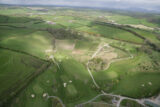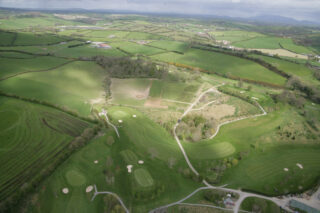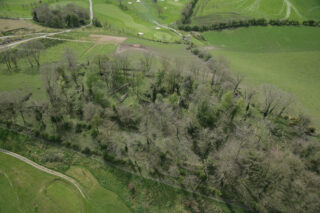Notice
Mannan Castle is a state-owned National Monument in the care of the Office of Public Works
WARNING: It should be noted that these sites are unguided and a level of care and caution should be maintained during all stages of your visit. The Office Of Public Works (OPW) will not be held responsible for any damages, injuries, or losses that occur
Mannan Castle
Mannan is a motte and bailey style castle, on a drumlin ridge running north-west to south-east. Unusually, Mannan has a double bailey and is considered to be the most impressive medieval earthwork in the country. The motte, a mound or raised hill on top of which the castle sat, is a truncated conical mound with a rectangular flat top. The stone work of the castle is encased on the top of this motte. The motte is surrounded by a fosse, with a top width of 24m, and outer bank, from which the fosse was made, 11.8m wide at the base. The bailey, an inner courtyard at the base of the motte, shows the presence of a stone wall defence and also a bank. The sub-rectangular bailey is 74m by 83m WNW/ESE and 32m by 52m north to south. The second bailey is identified by the scarps, or ditches to the north, south and east.
Excavations were carried out in 1910 by Henry Morris, who was much scuppered by the overgrowth. In 1994 permission to clear the site of overgrowth was given, which paved the way for a detailed archaeological survey.
Amongst the findings was an outer bailey that was used for intensive ironworking activity, with the presence of iron slag, iron nails, etc. The outer bailey had a defensive palisade. In the ditch between the two baileys were found the foundations of a wooden bridge connecting the inner and outer baileys. There was an earthen and timber-made castle sitting on top of the motte in 1197. By 1244 the motte and inner bailey were encased in stone.
In the mythological history of early Ireland, this site in the 4th century was the centre of power of the Three Collas, grandsons of the High King of Ireland Cairbre Lifechair. Their maternal grandfather was king of Alba, Udhaire. The Three Collas, Cairell Colla Uais, Muiredach Colla Fo Chrí and Áed Colla Menn, were exiled to Scotland by Muiredach Tirech after murdering his uncle, Fíacha Sroiptine. In time the three brothers returned and were held in the service of Muiredach Tirech. When the time came for the brothers to have their own territory, they conquered Ulster, burning Emain Macha. This resulted in the Collas gaining mid-to-south Ulster, Airgíalla (Oriel). Muiredach Colla Fo Chrí held Airgíalla and, over many centuries later, his descendants were O’Carroll’s Kings of Oriel.
After the Anglo Norman invasion in the 12th century, Murrough O’Carroll submitted to Henry II in 1172. Prince John had met with Murrough O’Carroll in 1185 and accepted that O’Carroll was the ruler of Oriel, but O’ Carroll’s successor would see nothing of the lands of Oriel. Prince John had granted O’Carroll’s lands to Gilbert Pipard and Bertram de Verdon. Murrough O’Carroll died in 1189 at Mellifont Abbey. The successor to Oriel was Mahon O’Carroll, who attempted to assay the incursions of Pipard and de Vernon. In Mahon O’Carroll’s final attempt to hold his lands of Oriel, in 1193 he was captured, blinded and hung. The earthen and timber castle sitting on top of the motte in 1197 was that of Mahon O’Carroll, last King of Oriel.
Visit Historic Environment Viewer for more information on Mannan Castle
Protect our Past - Click here to read about the importance of protecting our country’s unique heritage sites
This national monument is protected in accordance with the National Monuments Acts 1930 to 2014
Gallery
Nearby sites to visit
Old Mellifont Cistercian Abbey Monastic Site
Visit Ireland’s very first Cistercian foundation
Approx. 33.1 km from Mannan Castle
Carlingford Castle
A Norman citadel in the shadow of a giant
Approx. 33.7 km from Mannan Castle
Battle of the Boyne Visitor Centre – Oldbridge Estate
Where two kings fought for Europe’s future
Approx. 36.5 km from Mannan Castle
Brú na Bóinne Visitor Centre: Newgrange, Knowth and Dowth
Step into Ireland’s richest archaeological landscape
Approx. 38.5 km from Mannan Castle
Loughcrew Megalithic Cemetery
A high point of Neolithic art and design
Approx. 39.8 km from Mannan Castle
Hill of Tara
Experience the legacy of the high kings
Approx. 48.0 km from Mannan Castle



